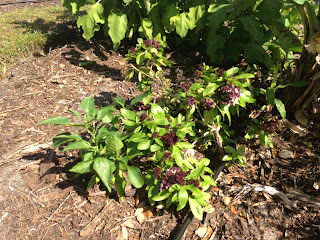The day started out a little slow, as our first class did
not show up to the garden as planned. We filled the time in with weeding and
planning out how our introduction to the Edible Peace Patch would go with the
other two classes that were scheduled. Before we knew it a group of
rambunctious 1st graders came running up, ready to go. We introduced
ourselves and then made an attempt to learn the kids’ names, but we knew that
remembering all of them would come with time. They had all been in the garden
before, so as we walked them through it they all pretty much new what the
plants were.
I found that the kids had less questions about the garden
and plants than our group at Maximo, but instead they had endless stories to
tell us. As we were trying to explain something to the whole group, there were
always at least a couple kids pulling at our shirts to share a personal
experience with us- from finding a snake in their flowerbed at home to telling
us about their favorite cartoon character, Spongebob, who lives in a pineapple
just like the ones we were planting. We found this extremely entertaining,
though it may have set back our productivity just a bit.
Earlier in our shift we found that there were two carrots
randomly placed in one of the smaller beds that had gotten very large and were
ready to pull. At the end of our session with the class, we had them gather
around the bed and pull out the carrots themselves and compare these carrots to
the ones they eat at home or see in the grocery store. The looks on their faces
were priceless. These carrots were covered in dirt, very wide at the top, but
short and fat on the bottom. These were not the perfectly sculpted baby carrots
they eat at lunchtime, and it was great to hear them talk about how different
these were to what they normally see.
The last class did not show up as well, so we spent that
time cleaning up and talking about what worked today and what we will do
differently in the future. Can’t wait to start the seed activity next week with
the classes!
Colby Hause










